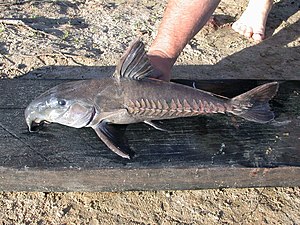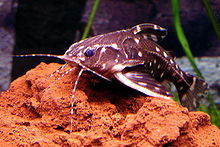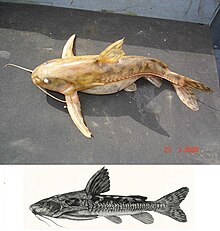Thorn catfish
| Thorn catfish | ||||||||||||
|---|---|---|---|---|---|---|---|---|---|---|---|---|

Black catfish ( Oxydoras niger ) |
||||||||||||
| Systematics | ||||||||||||
|
||||||||||||
| Scientific name | ||||||||||||
| Doradidae | ||||||||||||
| Bleeker , 1858 |
The spiny catfish (Doradidae) are freshwater fish from the rivers and lakes of northern and central South America (up to Buenos Aires ). The main area of distribution is the Amazon basin . The family comprises over 30 genera with around 90 known species. Most species are only a few inches to a foot tall. However, Oxydoras niger can grow to be a meter long.
features
Thorn catfish have a stocky shape, often tadpole-shaped with a broad trunk and a narrow tail stalk. The head is broad and flattened, the skull strongly ossified. The boundaries of the bone plates can also be seen through the skin of living animals. A bone plate of the skull extends on the dorsal side to the first, toothed spine of the dorsal fin. The pectoral fins also have a strong fin spine, which is often toothed or grooved. Along the flanks there is a row of roof-tile-like overlapping, mostly thorny bone plates. In Doraops zuloagai the row of bone plates is only present on the front body. The dorsal fin sits far in front, an adipose fin is usually present, but mostly small, rarely stretched. Bone plates can also be present in between. Thorn catfish have a long pair of barbels on the upper jaw and two significantly shorter ones on the lower jaw.
Way of life
Thorn catfish are usually crepuscular or nocturnal. The day is spent in the ground or hidden between plants, roots and leaves. They can anchor themselves with their strong pectoral fins. Most species are territorial , some also live in groups. Little is known about the reproduction of the thorn catfish. Some species should build nests and possibly take care of the brood.
Sound generation
In English, the Doradidae are also called "talking catfishes" because, like the African Mochokidae , they are able to produce audible sounds. When annoyed, they rub a dorsal bone process of the pectoral fin ray in a joint groove. The sounds arise both when moving the pectoral fin forward and backward. The spreading of the pectoral fin is slower and the sound is accordingly longer than when it is pulled. The pauses between the sounds are equally long. The greatest energy of the sounds is at frequencies between 2 and 4 kHz. The Mochokidae differ from the Doradidae only in the faster movement of the pectoral fins, ie the sounds and the pauses between the sounds are shorter than with the Doradidae.
Systematics
Together with the false thorn catfish (Auchenipteridae) the thorn catfish within the catfish-like (Siluriformes) form the superfamily Doradoidea.
Genera and species

- Family Doradidae (thorn catfish)
-
incertae sedis
- Genus Acanthodoras Bleeker, 1862
- Genus Agamyxis Cope, 1878
- Agamyxis albomaculatus ( Peters , 1877)
- Great crested catfish ( Agamyxis pectinifrons ( Cope , 1870) )
- Genus Franciscodoras Eigenmann, 1925
- Subfamily Astrodoradinae Higuchi, Birindelli, Sousa & Britski, 2007
- Genus Amblydoras Bleeker, 1862
- Amblydoras affinis
- Amblydoras bolivarensis
- Amblydoras gonzalezis
- Snarling catfish ( Amblydoras hancocki )
- Amblydoras monitor
- Amblydoras nauticus
- Genus Anadoras Eigenmann, 1925
- Genus Astrodoras Bleeker, 1862
- Genus Hypodoras Eigenmann, 1925
- Hypodoras forficulatus Eigenmann, 1925
- Genus Merodoras Higuchi, Birindelli, Sousa & Britski, 2007
- Merodoras nheco Higuchi et al., 2007
- Genus Physopyxis Cope, 1871
- Physopyxis lyra Cope, 1872
- Physopyxis ananas Sousa & Rapp Py-Daniel, 2005
- Physopyxis cristata Sousa & Rapp Py-Daniel, 2005
- Genus Scorpiodoras Eigenmann, 1925
- Scorpiodoras calderonensis (Vaillant, 1880)
- Scorpiodoras heckelii (Kner, 1855)
- Scorpiodoras liophysus Sousa & Birindelli, 2011
- Genus Amblydoras Bleeker, 1862
- Subfamily Doradinae Bleeker, 1858
- Genus Anduzedoras Fernández-Yépez, 1968
- Genus Centrochir Agassiz in Spix & Agassiz, 1829
- Genus Centrodoras Eigenmann, 1925
- Genus Doraops Schultz, 1944
- Genus Doras Lacepède, 1803
- Genus Hassar Eigenmann & Eigenmann, 1888
- Hassar affinis
- Hassar gabiru
- Hassar orestis
- Hassar shewellkeimi Sabaj Pérez & Birindelli, 2013
- Hassar wilderi
- Genus Hemidoras Bleeker, 1858
- Genus Leptodoras Boulenger, 1898
- Genus Lithodoras Bleeker, 1862
- Genus Megalodoras Eigenmann, 1925
- Genus Nemadoras Eigenmann, 1925
- Nemadoras cristinae Pérez et al., 2014
- Nemadoras elongatus
- Nemadoras hemipeltis
- Nemadoras humeralis
- Genus Orinocodoras Myers, 1927
- Genus Opsodoras Eigenmann, 1925
- Genus Ossancora Birindelli & Sabaj Pérez, 2011
- Ossancora asterophysa Birindelli & Sabaj Pérez, 2011
- Genus Oxydoras Kner, 1855
- Oxydoras kneri
- Black catfish ( Oxydoras niger )
- Oxydoras sifontesi
- Genus Platydoras Bleeker, 1862
- Line horned catfish ( Platydoras armatulus )
- Platydoras birindellii Sousa et al., 2018
- Platydoras brachylecis
- Platydoras costatus
- Platydoras hancockii
- Genus Pterodoras Bleeker, 1862
- Pterodoras granulosus ( Valenciennes , 1821)
- Pterodoras rivasi (Fernández-Yépez, 1950)
- Genus Rhinodoras Bleeker, 1862
- Rhinodoras armbrusteri Sabaj, Taphorn & Castillo G., 2008
- Rhinodoras boehlkei Glodek, Whitmire & Orcés, 1976
- Rhinodoras dorbignyi (Kner, 1855)
- Rhinodoras gallagheri Sabaj, Taphorn & Castillo G., 2008
- Rhinodoras thomersoni Taphorn & Lilyestrom, 1984
- Genus Rhynchodoras Klausewitz & Rössel, 1961
- Genus Tenellus Birindelli, 2014
- Tenellus leporhinus (Eigenmann, 1912)
- Tenellus ternetzi (Eigenmann, 1925)
- Tenellus trimaculatus (Boulenger, 1898)
- Genus Trachydoras Eigenmann, 1925
- Wertheimerinae Birindelli subfamily , 2014
- Genus Kalyptodoras Higuchi, Britski & Garavello, 1990
- Genus Wertheimeria Steindachner, 1877
-
incertae sedis
literature
- Kurt Fiedler: Textbook of Special Zoology, Volume II, Part 2: Fish . Gustav Fischer Verlag Jena, 1991, ISBN 3-334-00339-6 .
- Joseph S. Nelson : Fishes of the World , John Wiley & Sons, 2006, ISBN 0-471-25031-7 .
- Günther Sterba : The world's freshwater fish. 2nd Edition. Urania, Leipzig / Jena / Berlin 1990, ISBN 3-332-00109-4 .
Individual evidence
- ↑ Wolfgang Pfeiffer: The sound generation of the Dornwelse (Doradidae) and the Fiederbartwelse (Mochokidae) . ( PDF ) In: Zoomorphology . 54, 1965, pp. 669-679.
- ↑ JP Sullivan, Lundberg JG; Hardman M: A phylogenetic analysis of the major groups of catfishes (Teleostei: Siluriformes) using rag1 and rag2 nuclear gene sequences . In: Mol Phylogenet Evol. . 41, No. 3, 2006, pp. 636-62. doi : 10.1016 / j.ympev.2006.05.044 .
- ↑ a b c d e Birindelli, JLO: Phylogenetic relationships of the South American Doradoidea (Ostariophysi: Siluriformes). Neotropical Ichthyology, 2014 Sociedade Brasileira de Ictiologia, doi: 10.1590 / 1982-0224-20120027
- ↑ Sousa, LM & Birindelli, JLO 2011. Taxonomic Revision of the Genus Scorpiodoras (Siluriformes: Doradidae) with Resurrection of Scorpiodoras calderonensis and Description of a New Species. Copeia. 2011 (1): 121-140.
Web links
- Dornwelse on Fishbase.org (English)







